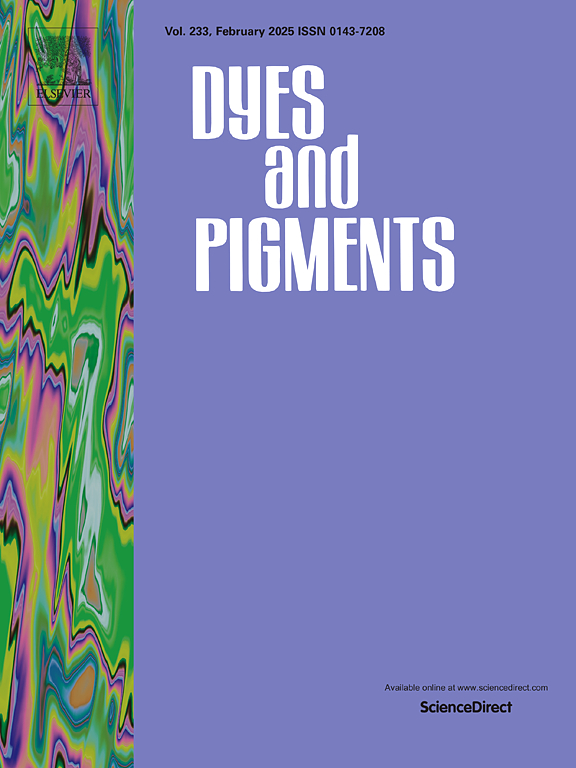Achieving high-performance non-doped OLEDs by combining AIE and HLCT luminescence features
IF 4.1
3区 工程技术
Q2 CHEMISTRY, APPLIED
引用次数: 0
Abstract
Organic light-emitting material that combines hybridized local and charge-transfer (HLCT) excited states and aggregation-induced emission (AIE) features not only breaks the 25 % exciton utilization efficiency (EUE) limit of the traditional fluorescence emitters, but also overcomes the aggregation-caused quenching (ACQ), making it highly suitable as the emitter for non-doped organic light-emitting diodes (OLEDs), especially for the long-wavelength emitters. Two orange HLCT emitters 4Ph-TPA-BTD and 3Ph-TPA-BTD were developed with rigid benzo[c][1,2,5]thiadiazole (BTD) as acceptor and triphenylamine (TPA) as donor. Tetraphenylethylene (TPE) or triphenylethylene (TriPE) was further linked to BTD acceptor, which plays the role of AIE functional group to improve the luminescence in solid state and also acts as the second weaker donor. It was observed that the AIE group participates the T2 state of each molecule, which happens to be the starting triplet state that undergoes the high-lying reverse intersystem crossing (hRISC) and therefore enhances the utilization of triplet excitons. Their photoluminescence quantum yields (PLQYs) in neat films were as high as 70.0 % and 61.1 % and the radiative transition rates exceeded 108 s−1. The orange non-doped OLED of 4Ph-TPA-BTD exhibited high EUE of 35.71 % and high EQE of 5.00 %, among the best performance for the non-doped AIE-HLCT OLEDs based on benzothiadiazole acceptor.
结合AIE和HLCT发光特性,实现高性能无掺杂oled
有机发光材料结合了杂化局域和电荷转移(HLCT)激发态和聚集诱导发射(AIE)特性,不仅打破了传统荧光发射体25%激子利用效率(EUE)的限制,而且克服了聚集引起的猝灭(ACQ),非常适合作为非掺杂有机发光二极管(oled)的发射体,特别是长波发射体。以刚性苯并[c][1,2,5]噻二唑(BTD)为受体,三苯胺(TPA)为供体,制备了两种橙色的HLCT发射体4Ph-TPA-BTD和3Ph-TPA-BTD。四苯基乙烯(TPE)或三苯基乙烯(TriPE)进一步与BTD受体连接,起到AIE官能团的作用,提高了BTD的固态发光能力,同时也是第二弱的给体。观察到AIE基团参与了每个分子的T2态,而T2态恰好是三重态的起始态,经历了高空反向系统间交叉(high- lie reverse intersystem crossing, hRISC),从而提高了三重态激子的利用率。它们在整齐薄膜中的光致发光量子产率(PLQYs)分别高达70.0%和61.1%,辐射跃迁率超过108 s−1。4Ph-TPA-BTD的橙色非掺杂OLED的EQE和EQE分别达到35.71%和5.00%,是基于苯并噻唑受体的非掺杂ae - hlct OLED中性能最好的。
本文章由计算机程序翻译,如有差异,请以英文原文为准。
求助全文
约1分钟内获得全文
求助全文
来源期刊

Dyes and Pigments
工程技术-材料科学:纺织
CiteScore
8.20
自引率
13.30%
发文量
933
审稿时长
33 days
期刊介绍:
Dyes and Pigments covers the scientific and technical aspects of the chemistry and physics of dyes, pigments and their intermediates. Emphasis is placed on the properties of the colouring matters themselves rather than on their applications or the system in which they may be applied.
Thus the journal accepts research and review papers on the synthesis of dyes, pigments and intermediates, their physical or chemical properties, e.g. spectroscopic, surface, solution or solid state characteristics, the physical aspects of their preparation, e.g. precipitation, nucleation and growth, crystal formation, liquid crystalline characteristics, their photochemical, ecological or biological properties and the relationship between colour and chemical constitution. However, papers are considered which deal with the more fundamental aspects of colourant application and of the interactions of colourants with substrates or media.
The journal will interest a wide variety of workers in a range of disciplines whose work involves dyes, pigments and their intermediates, and provides a platform for investigators with common interests but diverse fields of activity such as cosmetics, reprographics, dye and pigment synthesis, medical research, polymers, etc.
 求助内容:
求助内容: 应助结果提醒方式:
应助结果提醒方式:


